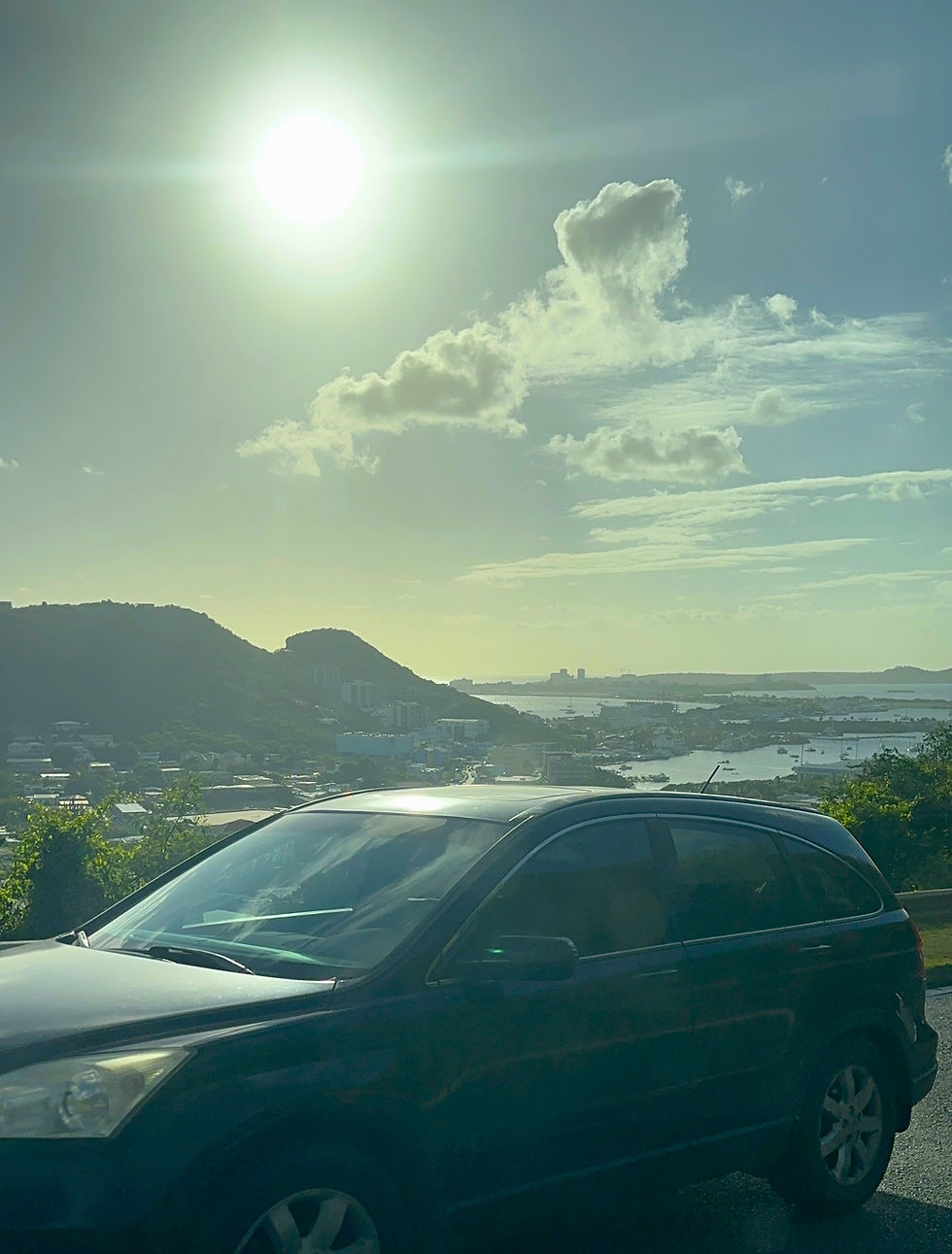Getting Around Sint Maarten and Saint Martin: Taxis, Buses, and the SXM Taxi App
- Mark Vogel

- May 20
- 5 min read
Sint Maarten/Saint Martin ✈

I landed at the Dutch side of Sint Maarten at Princess Juliana International Airport on an easy afternoon flight and faced the same choice every visitor confronts: rent a car or rely on local transport. The island’s compact size, just thirty-seven square miles, tempts many travelers to drive themselves. Rental desks line the arrivals hall, and every major agency operates just beyond the terminal. Driving feels familiar to American visitors because traffic keeps to the right, road signs follow continental conventions, and distances are short.
What complicates matters are the single-lane coastal roads, frequent roundabouts, and the fact that the busiest stretch between Simpson Bay and Philipsburg clogs whenever cruise ships disgorge their passengers. Parking varies from paved lots near Maho Beach and Grand Case to informal gravel pull-offs at smaller coves. Hotels usually provide spots for registered guests, though in Philipsburg you may sometimes have to loop side streets before claiming a space. Fuel is sold in liters and priced slightly higher on the French side of the island; stations prefer cash, and pumps shut for lunch. Insurance is mandatory, and agencies add a collision waiver unless you decline in writing. While driving is manageable, on this trip, I decided to test the transportation alternative the island provides.
Book a Tour: Top Sint Maarten Tours

“Sint Maarten markets itself as “The Friendly Island,” and my experience confirmed the slogan. When I was unsure of a stop, bus drivers and even fellow passengers stepped in to guide me without hesitation.”

Licensed taxis form the backbone of point-to-point travel. You cannot miss them at the airport exit, outside the cruise pier, and in front of large resorts. Each carries a T-number plate and a laminated rate sheet. Because cabs follow a zone system rather than a meter, knowing the published fare keeps haggling to a minimum. Airport to Philipsburg costs roughly thirty-five U.S. dollars, and the driver expects payment in cash even if you booked through a hotel desk. Tipping ten percent is polite, and luggage is included unless you require a trailer for surfboards.
If you’re used to Uber or Lyft, you can use the new SXM Taxi app. It mimics rideshare features without breaking local regulations. After downloading the app and entering a phone number, I pinpointed my location on a map, received the driver’s name, plate, and fare estimate, then watched the vehicle creep toward my location. After giving the driver a number generated by the app, we were on our way. No need to fumble with cash, as the ride was charged to my credit card, earning me extra miles for my next trip. Coverage stretches across both the Dutch and French sides, though remote beaches like Baie Rouge sometimes show longer wait times. The service launched in 2025, and early reviews highlight predictable pickups for cruise passengers racing an afternoon all-aboard time.

Cost prompts many travelers to sample the public “bus” network, a loose grid of privately owned vans that run fixed corridors yet stop anywhere. Vans display hand-painted signs behind the windshield: “Philipsburg-Maho,” “Marigot-Cole Bay,” or “Cupecoy-Simpson Bay.” Formal shelters with blue benches mark the main boarding points, but the true convenience lies in flagging a van from the sidewalk. Payment occurs when you exit; I passed two crisp single U.S. dollares forward and received a quick nod. Fares run about two dollars for most trips on the Dutch side and increase slightly for longer hops across the French border. Exact change matters. Drivers keep a plastic coin tray but dislike breaking twenties.

Timetables do not exist. Frequency follows demand: every few minutes on the Philipsburg-Maho road mid-morning, every fifteen minutes on the Marigot-Grand Case stretch, and unpredictably late at night. If no van appears after half an hour, taxis or the SXM Taxi app fill the gap. Still, I relied on buses for most daylight outings. The ride from Simpson Bay to Philipsburg took twenty minutes without traffic and cost a fraction of a taxi. Safety felt no different than in any Caribbean minibus system: keep valuables close, confirm your destination when boarding, and avoid solo rides after midnight unless you know the route. Sint Maarten markets itself as “The Friendly Island,” and my experience confirmed the slogan. When I was unsure of a stop, bus drivers and even fellow passengers stepped in to guide me without hesitation.

Several resorts supplement public options with guest shuttles. The Villas at Simpson Bay runs a courtesy van down the hill to the main road every hour. From there I either grabbed a bus. Larger all-inclusive properties near Cupecoy advertise charter vans to Maho and Philipsburg on set schedules, useful for travelers who don’t want to learn the bus system. Water transport also deserves a mention. In Philipsburg, a water taxi operates between the cruise pier and the boardwalk. The ride costs seven dollars for an all-day wristband—an indulgence if you are not sailing but a time-saver when heat and traffic converge downtown. Private water shuttles cross Simpson Bay Lagoon, linking the yacht marina to Marigot, though departures depend on charter demand and should not be counted on for routine commuting.

Scooter and quad rentals line Airport Road, tempting thrill-seekers. I passed because the accident record here is poor. Helmets are legally required yet seldom worn, potholes lurk near turnouts, and bursts of rain slick the pavement without warning. Bicycle rental exists in theory, but narrow shoulders and intense midday sun deter all but the most determined athletes. Hitchhiking enjoys some local acceptance on the French side, but visitors carrying beach bags and cameras should think twice before sticking out a thumb. Between taxis, buses, and resort shuttles, few tourists need to gamble on lifts from strangers.

Solo travelers and couples save money with the bus-and-taxi mix, while families or groups of four might find a rental economical once collective taxi fares add up. Comfort level with foreign roads is the real deciding factor. If tight turns above Oyster Pond or hairpin bends near Pic Paradise sound stressful, letting someone else drive is worth every dollar.

I recommend arriving with a plan matching your itinerary. Schedule taxis or the app for airport transfers and dinner runs, ride the vans for beach-hopping between Cole Bay and Maho, and use resort shuttles when available. Keep small bills, download the SXM Taxi app before leaving home, and ask hotel staff which bus shelters serve your route. With these basics you can explore both the Dutch nightlife of Simpson Bay and the French cafés of Marigot without ever turning an ignition key. Sint Maarten rewards curiosity, and its informal transport web makes spontaneous detours possible. By the time I boarded my return flight, I had covered a lot of the island without once gripping a steering wheel, and I left convinced that visitors can do the same with minimal stress and predictable costs.
Book a Tour: Top Sint Maarten Tours




















Comments